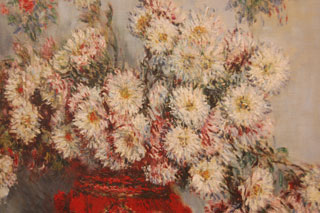Human Flower Project
Wednesday, November 01, 2006
Chrysanthemums – Too Human
A brief look at anti-chrysanthemumism.
 Exhibition winner
Exhibition winner
Photo: Southport Chrysanthemum Society
There IS such a thing as flower bigotry. Consider pansy disdain and the aspersions cast upon Bradford pear trees, carnations and chrysanthemums. One of our heroes, Pierre Bourdieu, spent many years studying the social and economic structures that underlie such “trivial” opinions. He argued that expressions of taste, even in things as seemingly subjective as flowers, belie an ongoing social struggle. One of the more bonehead—and prevailing—tactics in this culture war is the declared “preference” for things that are rare over things plentiful. The Fall Chrysanthemum Syndrome, if you will.
“The main opposition,” Bourdieu writes in Distinction, “is between the practices designated by their rarity as distinguished,” (what rich and culturally powerful people “like” and do) “and the practices socially identified as vulgar because they are both easy and common.” As chrysanthemums are common come November 1.
Back in the spring we came across a story in the Western Mail (Wales) reporting that the “Southport Chrysanthemum Society has been banned from putting their blooms at the local shopping centre because they’re not fashionable enough.” Dave Taylor, of Wildbunch Florists in Newtown, Powys, told the paper, “Chrysanthemums and carnations are so boring and old fashioned, no thought goes into buying them at all. The one good thing about them is that they can last for up to six weeks if taken care of. But service-station flowers just look so awful and cheap, it’s almost insulting to give them to a loved one.”
Dave isn’t alone in his view. Garden blogger Matt Mattus posted quite a screed back in June. “I am one who despises the bushel basket mums one sees at garden centers and home stores starting in September, opting instead for more interesting and unusual varieties.” His post takes an appreciative look back to the heyday of chrysanthemum clubs; these groups have been dwindling for several decades, but it seems only recently that mum fanciers, like those in Southport, have come in for overt condemnation.
Chrysanthemum antipathy is nothing terribly new. In a February 1892 edition of Garden and Forest, C.S. Sargent wrote, “It has been said that the popularity of the Chrysanthemum is on the wane. No doubt, the Japanese varieties have been overdone, but that the Chrysanthemum will ever become unpopular I do not believe. There will rather be a return to a larger variety of types, and many of the old kinds will come into favor. Already we see this.” Just as Bourdieu describes, to be “overdone” is anathema. Cultural salvation may come in the form of the “interesting or unusual” or the revival of “old kinds” that, like homespun blankets or Dedham Pottery, have become hard to find. In fact, banishment from shopping centers seems like a strong indication that these flowers are regaining a whiff of unacceptability, the first painful step on the road to grandeur.
 Chrysanthemums (detail), by Claude Monet, Musee d’Orday
Chrysanthemums (detail), by Claude Monet, Musee d’Orday
Photo: Julie Ardery
Chrysanthemums may also be maligned for carrying strong associations with death, notably in France. Today, in fact, is Toussaint (All Saints Day), when thousands of chrysanthemums will be taken to cemeteries across Europe. This Parisian blogger advises, “If invited to a French home for dinner, don¹t show up with a big chrysanthemum even though it is objectively a thoroughly attractive plant, it is too associated with cemeteries to be offered as a house gift!” (Monet clearly thought otherwise.)
U.S. garden writer Carol Wallace has the same dreary associations. “I grew up in the funeral business,” she writes, “and to me the ultimate funeral flower is the gladiola, followed by the chrysanthemum. I grow neither. For a longtime after leaving home I didn’t even like flowers because they were too associated with death. Maybe it is still why I am so fascinated with foliage, and why I have never had a cutting garden.”
Cees Dekker, who owns a major mum production facility in Northern Holland, is understandably spooked by anti-chrysanthemumism, taking it very seriously. “We are helping to give the chrysanthemum a new image amongst national and international consumers,” he says. And how to do that? “With new, striking and strong varieties such as the Madibas, with their strong, varied colors….” Dekker’s also named one of his company’s new varieties for Yoko Ono—funereal, slightly, but “easy and common,” not at all.
“Overdone” by hybridizers, hobbyists, marketers, morticians, the chrysanthemum seems to have been bruised by too many human fingerprints. In a peculiar book from 1902, however, we came upon an altogether different point of view. In his work The Double Garden, Maurice Maeterlinck devotes an entire chapter to this flower.
“I love the chrysanthemum,” he writes. “I follow its evolution with a brother’s interest. It is, among familiar plants, the most submissive, the most docile, the most tractable and the most attentive plant of all that we meet on life’s long way. It bears flowers impregnated through and through with the thought and will of man: flowers already human, so to speak. And, if the vegetable world is some day to reveal to us one of the words that we are awaiting, perhaps it will be through this flower of the tombs that we shall learn the first secret of existence.”
Culture & Society • Cut-Flower Trade • Florists • Religious Rituals • Permalink




